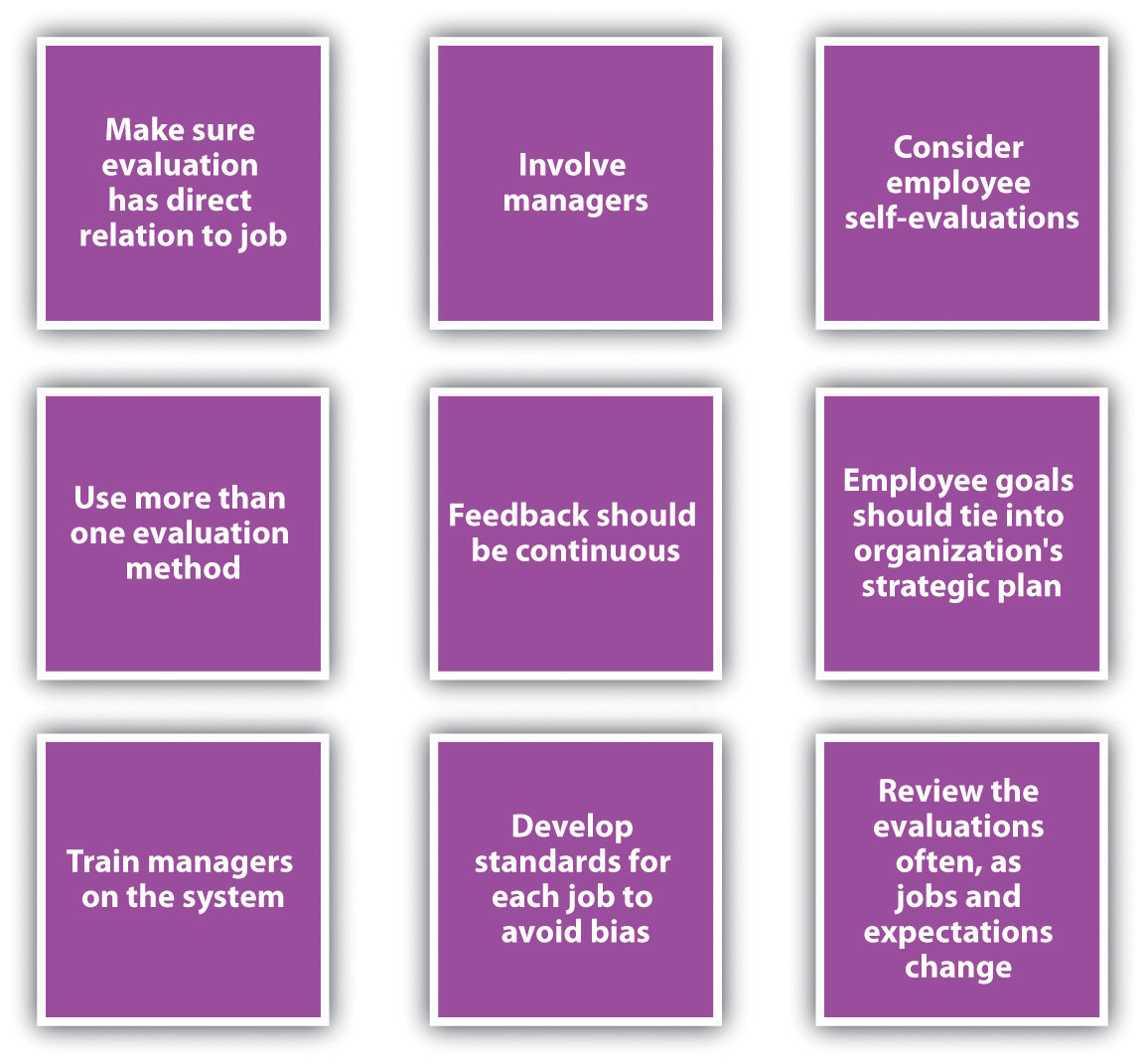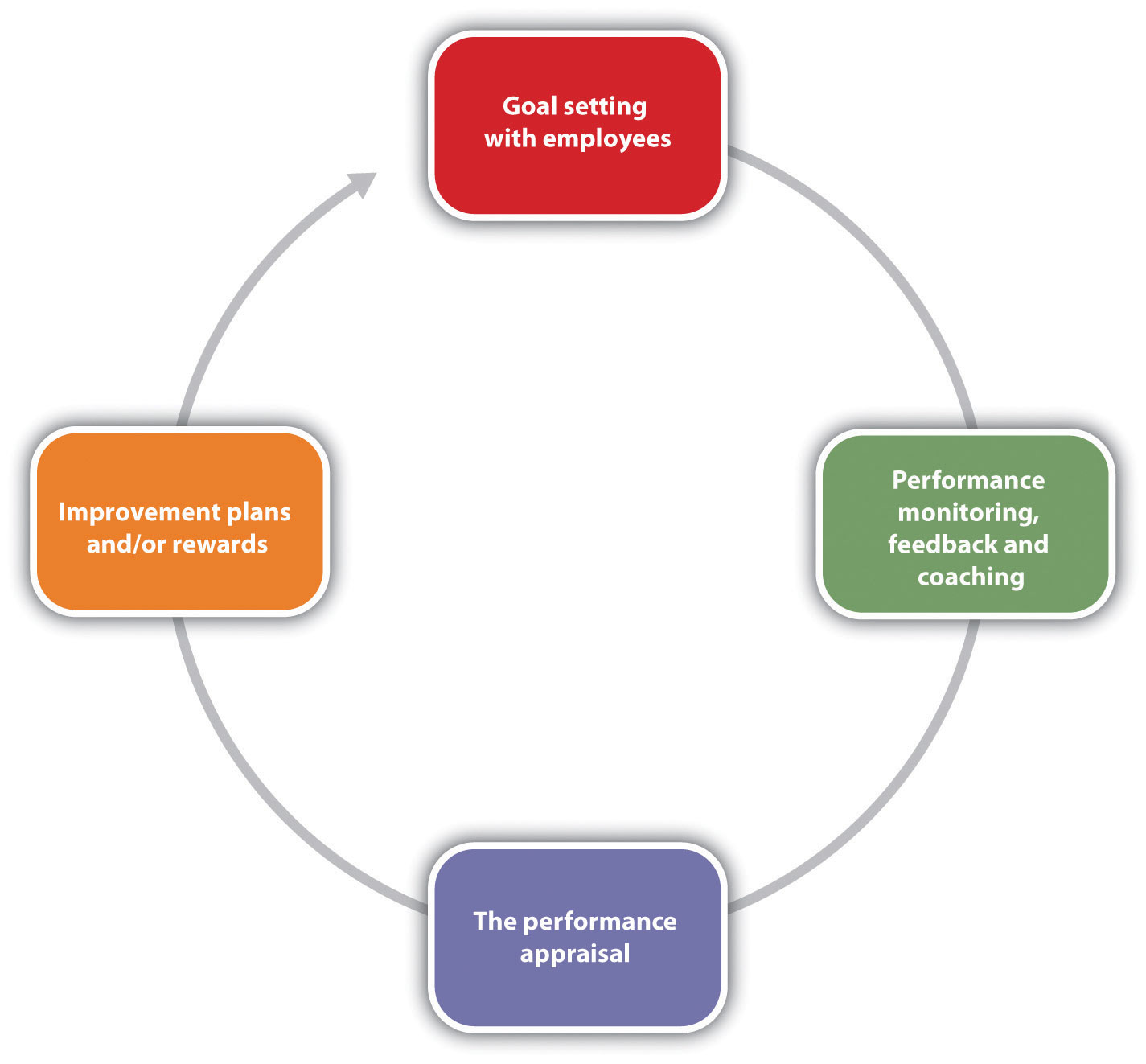This is “Completing and Conducting the Appraisal”, section 11.3 from the book Beginning Management of Human Resources (v. 1.0). For details on it (including licensing), click here.
For more information on the source of this book, or why it is available for free, please see the project's home page. You can browse or download additional books there. To download a .zip file containing this book to use offline, simply click here.
11.3 Completing and Conducting the Appraisal
Learning Objectives
- Be able to discuss best practices in performance review planning.
- Be able to write an improvement plan for an employee.
So far, we have discussed the necessity of providing formal feedback to employees through a systematic performance evaluation system. We have stressed the importance of making sure the HR professional knows how often performance evaluations should be given and if they are tied to pay increases.
The next step is to make sure you know the goals of the performance evaluation; for example, is the goal to improve performance and also identify people for succession planning? You will then determine the source for the performance evaluation data, and then create criteria and rating scales that relate directly to the employee’s job description. Once this is done, the successful functioning of the performance evaluation system largely depends on the HR professional to implement and communicate the system to managers and employees. This will be the primary focus of our next section.
Best Practices in Performance Appraisals
The most important things to remember when developing a performance evaluation system include the following:
- Make sure the evaluation has a direct relationship to the job. Consider developing specific criteria for each job, based on the individual job specifications and description.
- Involve managers when developing the process. Garner their feedback to obtain “buy-in” for the process.
- Consider involving the employee in the process by asking the employee to fill out a self-evaluation.
- Use a variety of methods to rate and evaluate the employee.
- Avoid bias by standardizing performance evaluations systems for each job.
- Give feedback on performance throughout the year, not just during performance review times.
- Make sure the goals of the performance evaluation tie into the organizational and department goals.
- Ensure the performance appraisal criteria also tie into the goals of the organization, for a strategic HRM approach.
- Review the evaluation for each job title often, since jobs and expectations change.
Figure 11.6 Best Practices in Performance Appraisal Systems

As you can see from Figure 11.7 "Performance Review System", the performance appraisal aspect is just one part of the total process. We can call this a performance review system. The first step of the process is goal setting with the employee. This could mean showing the employee his or her performance appraisal criteria or sitting down with the employee to develop MBOs. The basic idea here is that the employee should know the expectations and how his or her job performance will be rated.
Constant monitoring, feedback, and coaching are the next step. Ensuring the employee knows what he or she is doing well and is not doing well in a more informal manner will allow for a more productive employee.
Next, of course, is the formal performance evaluation process. Choosing the criteria, rating scale, and source of the evaluation are steps we have already discussed. The next step is to work with the employee to develop improvement plans (if necessary) and offer any rewards as a result of excellent performance. The process then begins again, setting new goals with the employee.
Figure 11.7 Performance Review System

Training Managers and Employees
As HR professionals, we know the importance of performance evaluation systems in developing employees, but this may not always be apparent to the managers we work with on a daily basis. It is our job to educate managers and employees on the standards for completing performance evaluation forms as well as train them on how to complete the necessary documents (criteria and ratings), how to develop improvement plans when necessary, and how to deliver the performance appraisal interview.
Employee Feedback
(click to see video)This video gives excellent tips on providing feedback to employees during the performance appraisal process.
First, after you have developed the new performance appraisal system (or adjusted an old one), consider offering training on how to effectively use it. The training, if required, can save time later and make the process more valuable. What we want to avoid is making it seem as if the performance appraisal process is “just one more thing” for managers to do. Show the value of the system in your training or, better yet, involve managers in developing the process to begin with.
Set standards should be developed for managers filling out the performance ratings and criteria. The advantage of this is accuracy of data and limiting possible bias. Consider these “ground rules” to ensure that information is similar no matter which manager is writing the evaluation:
- Use only factual information and avoid opinion or perception.
- For each section, comments should be at least two sentences in length, and examples of employee behavior should be provided.
- Reviews must be complete and shared with the employee before the deadline.
- Make messages clear and direct.
- Focus on observable behaviors.
Once your managers are trained, understand how to fill out the forms, and are comfortable with the ground rules associated with the process, we can coach them on how to prepare for performance evaluations. For example, here are the steps you may want to discuss with your managers who provide performance evaluations:
- Review the employee’s last performance evaluation. Note goals from the previous evaluation period.
- Review the employee’s file and speak with other managers who interface with this person. In other words, gather data about performance.
- Fill out the necessary forms for this employee’s appraisal. Note which areas you want to address in the appraisal interview with the employee.
- If your organization bases pay increases on the performance evaluation, know the pay increase you are able to offer the employee.
- Write any improvement plans as necessary.
- Schedule a time and date with the employee.
Most people feel nervous about giving and receiving performance evaluations. One way to limit this is to show the employee the written evaluation before the interview, so the employee knows what to expect. To keep it a two-way conversation, many organizations have the employee fill out the same evaluation, and answers from the employee and manager are compared and discussed in the interview. When the manager meets with the employee to discuss the performance evaluation, the manager should be clear, direct, and to the point about positives and weaknesses. The manager should also discuss goals for the upcoming period, as well as any pay increases or improvement plans as a result of the evaluation. The manager should also be prepared for questions, concerns, and reasons for an employee’s not being able to meet performance standards.
Improvement plansA document developed by both manager and employee to address any performance deficiencies. should not be punitive, but the goal of an improvement plan should be to help the employee succeed. Improvement plans are discussed in Chapter 7 "Retention and Motivation". Coaching and development should occur throughout the employee’s tenure, and he or she should know before the performance evaluation whether expectations are not being met. This way, the introduction of an improvement plan is not a surprise. There are six main components to an employee improvement plan:
- Define the problem.
- Discuss the behaviors that should be modified, based on the problem.
- List specific strategies to modify the behavior.
- Develop long- and short-term goals.
- Define a reasonable time line for improvements.
- Schedule “check-in” dates to discuss the improvement plan.
An employee improvement plan works best if it is written with the employee, to obtain maximum buy-in. Once you have developed the process and your managers are comfortable with it, the process must be managed. This is addressed in Section 11.3.3 "Organizing the Performance Appraisal Process".
Figure 11.8

Just the thought of a performance review can make even the most confident person stressed out.
© Thinkstock
Organizing the Performance Appraisal Process
While it will be up to the individual manager to give performance appraisals to employees, as an HR professional, it will be up to you to develop the process (which we have already discussed) and to manage the process. Here are some things to consider to effectively manage the process:
- Provide each manager with a job description for each employee. The job description should highlight the expectations of each job title and provide a sound basis for review.
- Provide each manager with necessary documents, such as the criteria and rating sheets for each job description.
- Give the manager instructions and ground rules for filling out the documents.
- Work with the manager on pay increases for each employee, if your organization has decided to tie performance evaluations with pay increases.
- Provide coaching assistance on objectives development and improvement plans, if necessary.
- Give time lines to the manager for each performance review he or she is responsible for writing.
Most HR professionals will keep a spreadsheet or other document that lists all employees, their manager, and time lines for completion of performance evaluations. This makes it easier to keep track of when performance evaluations should be given.
Of course, the above process assumes the organization is not using software to manage performance evaluations. Numerous types of software are available that allow the HR professional to manage key job responsibilities and goals for every employee in the organization. This software tracks progress on those goals and allows the manager to enter notes (critical incidents files) online. The software can track 360 reviews and send e-mail reminders when it is time for an employee or manager to complete evaluations. This type of software can allow for a smoother, more streamlined process. Of course, as with any new system, it can be time-consuming to set up and train managers and employees on how to use the system. However, many organizations find the initial time to set up software or web-based performance evaluation systems well worth the easier recording and tracking of performance goals.
No matter how the system is managed, it must be managed and continually developed to meet the ultimate goal—continuing development of employees.
The Performance Appraisal
(click to see video)This role-play highlights some of the things NOT to do when discussing a performance evaluation with an employee.
Performance Appraisal Interviews
Once a good understanding of the process is developed, it is time to think about the actual meeting with the employee. A performance review process could be intricately detailed and organized, but if the meeting with the employee doesn’t go well, the overall strategic objective of performance reviews may not be met. In Norman R. F. Maier’s famous book The Appraisal Interview, he addressed three types of appraisal interview styles. The first is the tell and sell interviewA type of performance appraisal interview in which the manager does most of the talking and passes his or her view to the employee.. In this type of interview, the manager does most of the talking and passes his or her view to the employee. In the tell and listenA type of performance appraisal interview in which the manager communicates feedback and then the employee’s thoughts about the interview are addressed. type of interview, the manager communicates feedback and then addresses the employee’s thoughts about the interview. In the problem-solving interviewA type of performance appraisal interview in which the employee and the manager discuss the things that are going well and the things that are not, which can make for a more productive discussion., the employee and the manager discuss the things that are going well and those that are not going well, which can make for a more productive discussion. To provide the best feedback to the employee, consider the following:
- Be direct and specific. Use examples to show where the employee has room for improvement and where the employee exceeds expectations, such as, “The expectation is zero accidents, and you have not had any accidents this year.”
- Do not be personal; always compare the performance to the standard. For example, instead of saying, “You are too slow on the production line,” say, the “expectations are ten units per hour, and currently you are at eight units.”
- Remember, it is a development opportunity. As a result, encourage the employee to talk. Understand what the employee feels he does well and what he thinks he needs to improve.
- Thank the employee and avoid criticism. Instead of the interview being a list of things the employee doesn’t do well (which may give the feeling of criticizing), thank the employee for what the employee does well, and work on action plans together to fix anything the employee isn’t doing well. Think of it as a team effort to get the performance to the standard it needs to be.
The result of a completed performance evaluation usually means there are a variety of ramifications that can occur after evaluating employee performance:
- The employee now has written, documented feedback on his or her performance.
- The organization has documented information on low performance, in case the employee needs to be dismissed.
- The employee has performed well and is eligible for a raise.
- The employee has performed well and could be promoted.
- Performance is not up to expectations, so an improvement plan should be put into place.
- The employee hasn’t done well, improvement plans have not worked (the employee has been warned before), and the employee should be dismissed.
In each of these cases, planning in advance of the performance appraisal interview is important, so all information is available to communicate to the employee. Consider Robin, an employee at Blewett Gravel who was told she was doing an excellent job. Robin was happy with the performance appraisal and when asked about promotion opportunities, the manager said none was available. This can devalue a positive review and impact employee motivation. The point, of course, is to use performance evaluations as a development tool, which will positively impact employee motivation.
Preparing and Giving the Performance Appraisal
(click to see video)Some great tips on preparing for the performance appraisal meeting, and how to handle the meeting.
Key Takeaways
- There are many best practices to consider when developing, implementing, and managing a performance appraisal system. First, the appraisal system must always tie into organization goals and the individual employee’s job description.
- Involvement of managers in the process can initiate buy-in.
- Consider using self-evaluation tools as a method to create a two-way conversation between the manager and the employee.
- Use a variety of rating methods to ensure a more unbiased result. For example, using peer evaluations in conjunction with self- and manager evaluations can create a clearer picture of employee performance.
- Be aware of bias that can occur with performance appraisal systems.
- Feedback should be given throughout the year, not just at performance appraisal time.
- The goals of a performance evaluation system should tie into the organization’s strategic plan, and the goals for employees should tie into the organization’s strategic plan as well.
- The process for managing performance evaluations should include goal setting, monitoring and coaching, and doing the formal evaluation process. The evaluation process should involve rewards or improvement plans where necessary. At the end of the evaluation period, new goals should be developed and the process started over again.
- It is the HR professional’s job to make sure managers and employees are trained on the performance evaluation process.
- Standards should be developed for filling out employee evaluations, to ensure consistency and avoid bias.
- The HR professional can assist managers by providing best practices information on how to discuss the evaluation with the employee.
- Sometimes when performance is not up to standard, an improvement plan may be necessary. The improvement plan identifies the problem, the expected behavior, and the strategies needed to meet the expected behavior. The improvement plan should also address goals, time lines to meet the goals, and check-in dates for status on the goals.
- It is the job of the HR professional to organize the process for the organization. HR should provide the manager with training, necessary documents (such as criteria and job descriptions), instructions, pay increase information, and coaching, should the manager have to develop improvement plans.
- Some HR professionals organize the performance evaluation information in an Excel spreadsheet that lists all employees, job descriptions, and due dates for performance evaluations.
- There are many types of software programs available to manage the process. This software can manage complicated 360 review processes, self-evaluations, and manager’s evaluations. Some software can also provide time line information and even send out e-mail reminders.
- The performance evaluation process should be constantly updated and managed to ensure the results contribute to the success of the organization.
- A variety of ramifications can occur, from the employee’s earning a raise to possible dismissal, all of which should be determined ahead of the performance appraisal interview.
Exercises
- What are the important aspects of an improvement plan? Why are these so important?
- Name and describe three best practices for a performance evaluation system.




